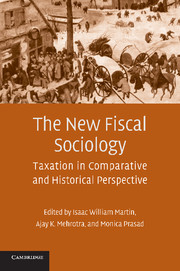Book contents
- Frontmatter
- Contents
- List of Contributors
- Acknowledgments
- Foreword
- 1 The Thunder of History: The Origins and Development of the New Fiscal Sociology
- PART ONE SOCIAL SOURCES OF TAXATION: AMERICAN TAX POLICY IN COMPARATIVE PERSPECTIVE
- 2 “The Unfair Advantage of the Few”: The New Deal Origins of “Soak the Rich” Taxation
- 3 What Americans Think of Taxes
- 4 Read Their Lips: Taxation and the Right-Wing Agenda
- 5 Making Taxes the Life of The Party
- PART TWO TAXPAYER CONSENT
- PART THREE THE SOCIAL CONSEQUENCES OF TAXATION
- References
- Index
5 - Making Taxes the Life of The Party
Published online by Cambridge University Press: 13 January 2010
- Frontmatter
- Contents
- List of Contributors
- Acknowledgments
- Foreword
- 1 The Thunder of History: The Origins and Development of the New Fiscal Sociology
- PART ONE SOCIAL SOURCES OF TAXATION: AMERICAN TAX POLICY IN COMPARATIVE PERSPECTIVE
- 2 “The Unfair Advantage of the Few”: The New Deal Origins of “Soak the Rich” Taxation
- 3 What Americans Think of Taxes
- 4 Read Their Lips: Taxation and the Right-Wing Agenda
- 5 Making Taxes the Life of The Party
- PART TWO TAXPAYER CONSENT
- PART THREE THE SOCIAL CONSEQUENCES OF TAXATION
- References
- Index
Summary
This volume is designed to facilitate cross-national comparisons of taxation. Because the chapters in this section focus on different periods in U.S. history, we can track change over time as well. During the 1930s, the main advocates of progressive taxation were members of the Roosevelt administration, liberal Democrats in Congress, and liberal media outlets such as The Nation and The New Republic. Their main adversaries were businesses and the rich, which made sense considering that they were basically the only ones paying income taxes at the time. Tax politics was an ongoing battle between political elites and economic elites (see Chapter 2). Between the 1940s and 1960s, elected officials broadened the base of the income tax and increased tax rates. Nevertheless, the general public exerted little influence on tax policy, and political elites continued to be the central actors. When elected officials started to talk more about taxes in the 1970s, the public became more involved. Taxes became a bigger influence on voting behavior, and citizens became more concerned about the level of taxation (see Chapter 3). In this context, it became easier for conservative elites to mount a sustained drive to cut taxes, which began with Reagan and continued through the George W. Bush administration (see Chapter 4).
Like Fred Block, I am interested in tax politics during the late twentieth and early twenty-first centuries. However, the story I tell is rather different.
- Type
- Chapter
- Information
- The New Fiscal SociologyTaxation in Comparative and Historical Perspective, pp. 86 - 100Publisher: Cambridge University PressPrint publication year: 2009
- 6
- Cited by



